|

by Peter Dockrill
April
29, 2019
from
ScienceAlert Website
Italian version
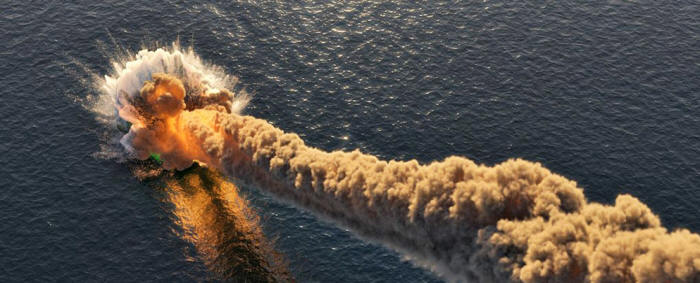
It came out of nowhere...
Just a few short weeks
ago - in an alternate reality otherwise identical to our own - it
popped up on our screens: a giant asteroid hurtling through space,
and headed straight for us.
At least, maybe it is. Nobody really knows.
In this hypothetical
scenario, the facts on the ground change fast. At first, scientists
say there's only a one-in-50,000 chance this thing will hit us.
Within weeks, those odds
become one in 100...
There's good news and bad news about this approaching object, called
2019 PDC. The good news is 2019 PDC doesn't exist at all. It's a
completely fictional, imaginary apocalypse. The chance of impact, in
actuality, is zero.
The bad news is that 2019 PDC - or an NEO (Near Earth Object) very
much like it - so easily could be real.
Because of that, this week NASA, Federal Emergency Management
Agency (FEMA) and international partners including the
European
Space Agency (ESA) are conducting a drill:
a 'tabletop exercise'
to simulate how a planetary asteroid emergency would play out in
real time.
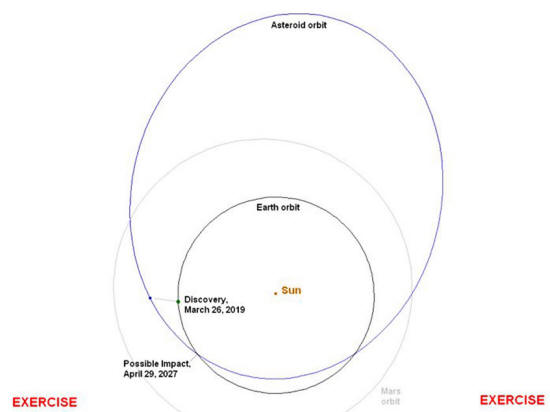
Orbit of Asteroid 2019 PDC.
(CNEOS)
NASA's been running these simulations for years, and with good
reason:
Earth, as it happens, is in the midst of an epic asteroid
surge compared to the relative peace and quiet the planet
experienced many millions of years ago.
When unexpected space rocks do appear on our scopes, sometimes we
only get hours' notice of their existence before they streak past.
While the chances of a
catastrophic impact are exceedingly slim, we're nonetheless
unprepared for surprise asteroid strikes, which is why NASA is
continually working on plans to help improve our NEO detection and
mitigation capabilities.
Part of that was the formation in 2016 of a new Planetary Defence
Coordination Office (PDCO), which will help run the drill
exercise this week, designed by researchers at the NASA Jet
Propulsion Laboratory's Centre for NEO Studies (CNEOS).
"The first step in
protecting our planet is knowing what's out there," says the
ESA's Head of Planetary Defence, Rüdiger Jehn.
"Only then, with enough warning, can we take the steps needed to
prevent an asteroid strike altogether, or to minimize the damage
it does on the ground."
In the 2019 PDC scenario
- being run as part of the 2019 Planetary Defence Conference held in
Washington, DC from Monday through to Friday - the object is first
picked up on 26 March 2019.
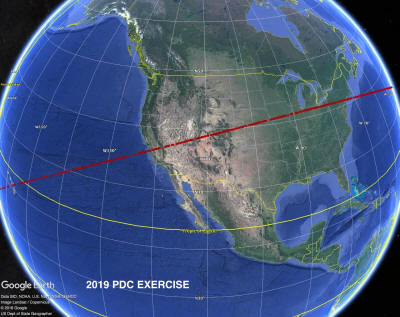 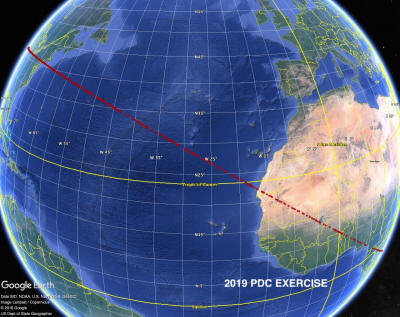
Projected risk corridor.
(CNEOS)
Unlike the 150 or so NEOs scientists discover each month, initial
calculations suggest 2019 PDC is a 'Potentially Hazardous Asteroid',
estimated to range up to 300 meters in size and potentially on a
collision course with Earth.
Further analysis reveals the most likely date of impact will be 29
April 2027 - eight years to the day from today - and projects an
estimated 'risk corridor':
a red line of danger spanning the globe
where the asteroid, if it hits at all, may hit.
That red line neatly traverses the middle of the US, in addition to
other land masses including Africa, and the latest information to
hand suggests 2019 PDC has about a 1 percent chance of hitting
Earth.
The simulation, which begins today, will run until the end of the
week, and see participants from NASA, FEMA, the ESA and more all
receive daily briefings and updates on the asteroid's trajectory, as
the world's real space agencies combine forces to confront an unreal
but not unimaginable threat.
As part of the exercise, participants will discuss things like
asteroid deflection opportunities (if they exist), address funding
issues, and consider how to manage the public's reaction to an
Armageddon only eight years away, as well as drawing up plans for
pre- and post-disaster relief.
For the first time in one of these asteroid emergency drills, you'll
be able to keep track of the hypothetical situation as it evolves,
with daily updates at the
@esaoperations Twitter channel and the
ESA's Rocket Science blog, plus you can keep tabs on 2019's PDC
orbital trajectory at the CNEOS website.
"This topic has been
the theme of many epic films and TV series," ESA Operations
tweeted.
"But what really are the chances of an asteroid impact and what
are our options? Bruce Willis unfortunately isn't on Twitter."
Of Asteroids
...and Electrostatic Generators
by Joseph P.
Farrell
May 03, 2019
from
GizaDeathStar Website
|
Joseph P. Farrell has a
doctorate in patristics from the University of Oxford,
and pursues research in physics, alternative history and
science, and "strange stuff". His book
The Giza Death Star,
for which the Giza Community is named, was published in
the spring of 2002, and was his first venture into
"alternative history and
science". |
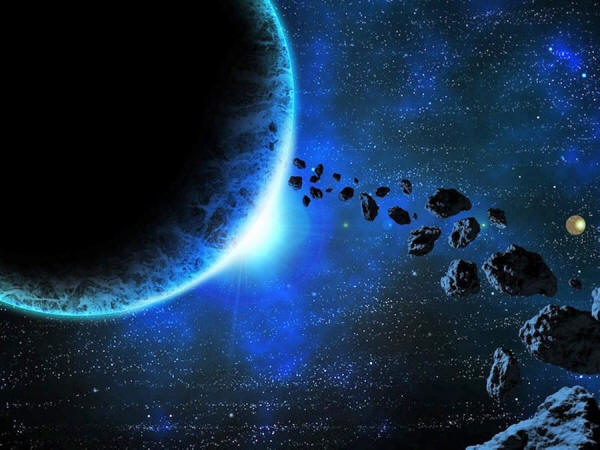
I'm always amazed at the ability of the "Gizars" to spot intriguing
information, especially if it concerns technologies that don't
normally "show up on the radar" of the
lame-stream corporate controlled media,
nor, for that matter, on the radar of the alternative research
field.
But L.G.R. spotted this
one, and passed it along.
And it's a doozie.
"It" in this case is a patent filing from 2017, rather blandly
titled "Electromagnetic Field Generator and method to generate an
electromagnetic field", interestingly enough the assignee is the US
government via the Secretary of the Navy.
There are several intriguing things about this patent application,
not the least of which are the first two paragraphs:
The invention described herein may be manufactured and used by or
for the Government of the United States of America for governmental
purposes without payment of any royalties thereon or therefore.
And why would the USA want to do that?
Well, paragraph two provides
the answer:
To date there are more than 100,000 potentially dangerous asteroids
(Near Earth Objects) which cross the earth's orbit, with only,
11,000 having been catalogued and currently tracked.
Earth will be
impacted again and again; it is only a matter of time and
circumstance. Therefore, there is a need for an effective method to
deflect or destroy these potentially dangerous asteroids.
That, of course, reveals itself to be
the purpose of the patent, and
of course, if you're like me, you've probably also noted the more or
less "coincidental" appearance of this patent within a year of the
Trump Administration's creation of
a "space force".
After reviewing a few
other methods of deflecting asteroids in paragraph three, the patent
description observes that,
"the techniques
described... would only affect 'small' asteroids, on the average
diameter levels of approximately 100 meters."
Implication:
we need
something that can take care of the really big ones, and that is not
subject to the hazards of kinetic targeting (with its chances for a
"miss") and the resulting fragmentation of the asteroid, which could
be as dangerous as the asteroid itself as many potential impacts
would replace just one.
And thus,
"the present
invention is directed to an electromagnetic field generator and
a method to generate an electromagnetic field with the needs
enumerated above," i.e., something strong enough to "deflect or
destroy" a big asteroid.
And when you read the
details in the filing, you might, like me, be thinking that "this
sounds vaguely familiar" and that it might "ring a Bell."
Oh, and in case you missed it, it's also a handy thing to have
around for some "other" purposes:
It is a feature of
the present invention to provide a method and apparatus for
generating an impenetrable defensive shield to Sea and Land as
well as Space-based military and civilian assets, protecting
these assets from such threats as Anti-Ship Ballistic Missiles,
Radar Evading Cruise Missiles, Top Attack for main battle
tanks...
Oh... did we mention,
it's capable of a little solar manipulation as well?:
...as well as
counteracting the effects of solar-induced Coronal Mass
Ejections...
(Paragraph 0012)
Presumably it will do all
this by generating electromagnetic fields, which, to accomplish all
these feats, would have to be extraordinarily strong, but not to
worry, because the,
"the design of energy
generation machinery with power output levels much higher than
those currently achievable by conventional means, is made
possible with this invention."
(Paragraph (0012)
At this point, the patent
goes on to outline how it's going to do all of this, and
behold, it does so by spinning a plasma, utilizing shells in a
sphere of piezoelectric ceramics doped with radioactive materials.
Of course, I'm
over-simplifying, but the end result of all of this is that this
creates the
Mossbauer Effect of vibrationally stimulated and cohered
releases of gamma rays.
All of this, according to
paragraph 30, will generate field strengths per square meter of (get
this) 10,000,000,000,000,000,000,000,000 to
100,000,000,000,000,000,000,000,000,000 watts.
That's ten septillion to
one hundred octillion watts... per square meter...
I don't know about you, but this seems to me to be quite a lot of
deflection. Maybe even enough to "grab and throw"; it's a handy
thing to have around to "snag" an asteroid, mine it, and then throw
it away.
And you could make it do
double duty:
when you're done mining it, you could throw it at
someone you don't like...
| 





